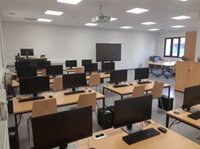
Prof. Dr. Andreas Berl
Dean
- Dean of the Faculty of Applied Computer Science
- Course coordinator for the Artificial Intelligence and Data Science master’s course
consulting time
Monday 13h - 14h
labs
Deep Learning AI lab (Deggs)
core competencies
- Electromobility and fleet management
- Virtualisation and energy efficiency
- Smart Grid
Research and teaching areas
Projekts
- SmiLE - Smartes und integriertes Laden von Elektrofahrzeugen auf Firmenparkplätzen https://zaf.th-deg.de/public/project/183 Bayerische Forschungsstiftung 05/2020 - 04/2023 (3 years)
- MAID - “Master Artificial Intelligence and Data Science” https://zaf.th-deg.de/public/project/114 EU, INTERREG 03/2019 - 12/2022 (3.75 years)
- CITRAM - “Citizen Science for Traffic Management” https://zaf.th-deg.de/public/project/101 BMVI - mFund 09/2018 - 10.2023 (3 years)
- SMART-vhb - “Java Programming” Virtuelle Hochschule Bayern https://smart.vhb.org 09/2019 - 10/2022 (3 years)
- Smart Grid - “Smart Grid-Technologien für ländliche Gebiete und KMUs” http://www.smartgrid.science EU, INTERREG 04/2017 - 03/2020 (3 years)
- WVDI - “Workstation-based virtual desktop infrastructure” https://zaf.th-deg.de/public/project/54 Sonderforschungsprojekt der THD 01/2017 - 12/2018 (2 years)
- Electrific - “Enabling seamless electromobility through smart vehicle-grid integration” https://www.electrific.eu EU, Horizon 2020 09/2016 - 08/2019 (3 years)
Teaching
- Foundations of computer science
- Introduction to programming (in C)
- Programming 1 (in Java)
- Programming 2 (in Java)
- Architectures for networked software systems
- Network technology and IT networks
- Project management
Vita
- 2019 - 2022 Dean of the Faculty of Applied Computer Science
- since 2021 Course coordinator for the Artificial Intelligence and Data Science master’s course
- 2019 - 2024 Member of the examination committee of the department Applied Informatics / Infotronik.
- 2019 - 2022 Member of the Faculty Council of the Faculty of Applied Computer Science
- 2019 Change to the department „Applied Informatics / Infotronik“.
- 2018 - 2022 Research professorship, combined with a reduction in teaching to 9 SWS.
- 2015 - 2019 Member of the examination committee of the department Electrical Engineering, Media Technology, and Computer Science.
- 2015 - 2024 Course Consultant of Applied Informatics / Infotronik.
- since 2015: Professor for “Grundlagen der Informatik (Principles of computer science)” at the Deggendorf Institute of Technology, department of Electrical Engineering, Media Technology, and Computer Science.
- 2005-2015: Research, teaching and project work in national and international research projects at the department of computer networks and computer communications, University of Passau.
- 2011: PhD at the University of Passau, topic: „Energy Efficiency in Office Computing Environments“. Awarded with „Wissenschaftspreis der Universität Passau 2012“.
- 2009: Guest scientist at the Computing Department, Lancaster University, GB.
- 2000-2005: Studies of computer science and psychology, University of Passau.
